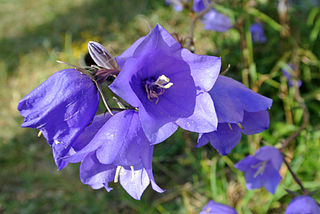
Campanula is the type genus of the Campanulaceae family of flowering plants. Campanula are commonly known as bellflowers and take both their common and scientific names from the bell-shaped flowers — campanula is Latin for "little bell".

The family Campanulaceae, of the order Asterales, contains nearly 2400 species in 84 genera of herbaceous plants, shrubs, and rarely small trees, often with milky sap. Among them are several familiar garden plants belonging to the genera Campanula (bellflower), Lobelia, and Platycodon (balloonflower). Campanula rapunculus and Codonopsis lanceolata are eaten as vegetables. Lobelia inflata, L. siphilitica and L. tupa and others have been used as medicinal plants. Campanula rapunculoides may be a troublesome weed, particularly in gardens, while Legousia spp. may occur in arable fields.
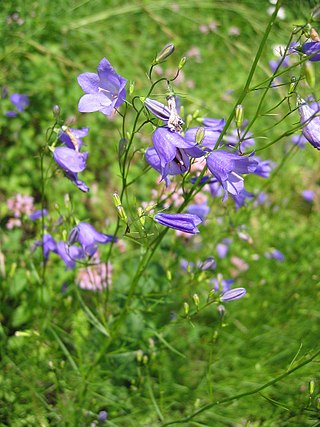
Campanula rotundifolia, the harebell, Scottish bluebell, or bluebell of Scotland, is a species of flowering plant in the bellflower family Campanulaceae. This herbaceous perennial is found throughout the temperate regions of the northern hemisphere. In Scotland, it is often known simply as bluebell. It is the floral emblem of Sweden where it is known as small bluebell. It produces its violet-blue, bell-shaped flowers in late summer and autumn.

Phyteuma is a genus of flowering plants in the family Campanulaceae, native to Europe and Morocco.

Campanula exigua, the chaparral bellflower, rock harebell, or Rattan campanula, is an annual flowering plant in the bellflower family Campanulaceae.

Downingia bella, also known as Hoover's calicoflower or Hoover's Downingia, is a member of the Bellflower Family (Campanulaceae). The genus is named after A.J. Downing (1815–1852) a noted American horticulturist and landscape architect.
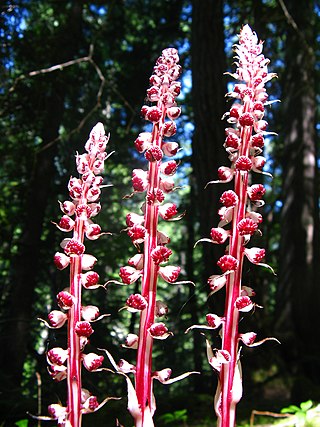
Allotropa virgata is in the family Ericaceae and is the only species of the genus Allotropa. It is a perennial plant that gets its common names from the distinct white and red or maroon stripes along its erect peduncle. A. virgata are nongreen as they lack chlorophyll, instead obtaining nutrition from neighboring green plants through a fungal intermediate.

Campanula cervicaria, the bristly bellflower, is a species of flowering plant in the bellflower family Campanulaceae. The plant is roughly hairy and the flowers are about 1–2 centimetres (0.4–0.8 in) long, light blue and are grouped together.

Campanula latifolia, the giant bellflower, is a species of bellflower in the family Campanulaceae. It is also known as the large campanula and the wide-leaved bellflower. It is native to Europe and western Asia and is widely grown as an ornamental plant.

Campanula rapunculoides, known by the common names creeping bellflower, rampion bellflower, rover bellflower, garden bluebell, creeping bluebell, purple bell, garden harebell, and creeping campanula, is a perennial herbaceous plant of the genus Campanula, belonging to the family Campanulaceae. Native to central and southern Europe and west Asia, in some parts of North America it is an extremely invasive species.
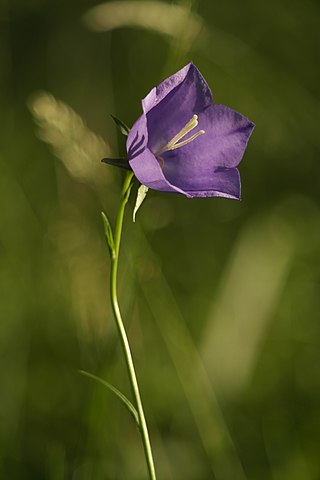
Campanula persicifolia, the peach-leaved bellflower, is a flowering plant species in the family Campanulaceae. It is an herbaceous perennial growing to 1 m. Its flowers are cup-shaped and can be either lilac-blue or white. Its foliage is narrow and glossy with a bright green appearance.

Calochortus dunnii is a rare species of flowering plant in the lily family known by the common name Dunn's mariposa lily.

Chaenactis suffrutescens is a species of flowering plant in the aster family known by the common name Shasta chaenactis.

Leptosiphon parviflorus is a species of flowering plant in the phlox family known by the common name variable linanthus.
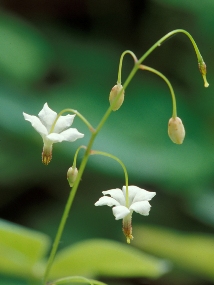
Vancouveria planipetala is a species of flowering plant in the barberry family known by the common names redwood inside-out flower and redwood ivy.

Campanula piperi is a species of flowering plant in the bellflower family, Campanulaceae. It is native to the Olympic Mountains on the Olympic Peninsula in the U.S. state of Washington. It has also been noted on Vancouver Island, British Columbia.

Wahlenbergia capillaris, commonly known as tufted bluebell, is a plant in the family Campanulaceae and is native to Australia and New Guinea. It is an erect perennial herb with a few to many stems and grows to a height of 50 cm (20 in). The leaves are mostly linear with a few scattered teeth on the sides and the flowers are blue, bell-shaped with five lobes and arranged in cymes. This bluebell is widespread and common, occurring in all Australian mainland states and territories.
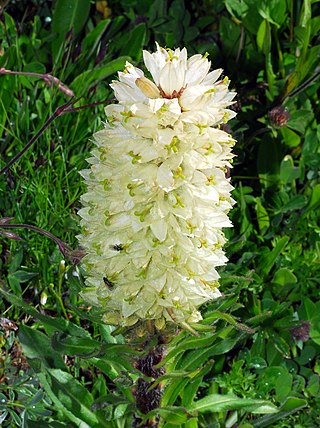
Campanula thyrsoides is a flowering plant belonging to the family Campanulaceae.

Campanula petiolata, is a wild flower that is called western harebell when it is distinguished from Campanula rotundifolia or simply harebell when it is considered the same species. It is a species of flowering plant in the bellflower family Campanulaceae. This herbaceous perennial is found through much of the temperate areas of North America. It produces its violet-blue, bell-shaped flowers in late summer and autumn. It is closely related to Campanula rotundifolia and is considered either a subspecies or the same species by many botanists.

Smithiastrum is a genus of plants in the Campanulaceae or bellflower family found in the western United States. Its members are commonly known as harebells and were previously included in the family's type genus, Campanula, and were segregated when it was found that the Campanula was polyphyletic. As of 2023, Smithiastrum comprises two species.






















